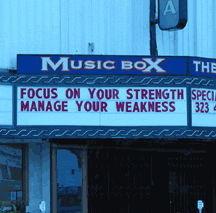This is the way most people learn a tennis stroke: an instructor stands across the net from the student and tells the student to bring their racket back, bend their knees, keep the racket level, brush up on the ball, follow through and any number of other instructions to help them construct a useful tennis swing. The idea is that each step is practiced until it becomes automatic then you go onto the next step. Let’s call this learning in bits and pieces.

I take periodic lessons with Sean Brawley. He is certified by Timothy Gallwey, the Inner Game of Tennis guy. Sean seldom gives me technical instruction. Instead of telling me to bring my racket back or brush up on the ball or follow through, he suggests that I think about where I want the ball to go as I’m hitting it. If it doesn’t go where I want it to go, he suggests noticing what I was doing and making an adjustment. If I keep running into the ball on my backhand, for instance, I hit a number of backhands and after each one ask myself on a scale of 1-5 whether I was close or far away when I made contact with the ball. In other words, he gives me exercises to increase my awareness rather than telling me what to do.
I recently had a phone session with David Gorman. He teaches an approach called Learning Methods. The Inner Game of Tennis and Learning Methods both suggest thinking about where you want the ball to go then letting your body figure out how to get it there. However, if the ball doesn’t go where it should, Learning Methods looks at the thought that led to that result.
I switched to a one-handed backhand after a few years of hitting two-handed. One reason I changed was to get more topspin on the ball. I thought that I had to hit up on the ball sharply to get topspin but when I tried that, the ball ended up barely reaching the net. When I changed my focus to hitting a certain point on the opposite court, my stroke adjusted to get the ball to that point. My original, incorrect thought was interfering with getting the ball over the net.
If you focus on the goal at hand, getting the ball over the net and to a certain point on the court, and let your body carry out that goal, you can expect a smooth motion. That’s exactly how your body carries out most of its functions when there is no unnecessary interference.
There are problems with learning in bits and pieces. The first problem is the idea that the steps become automatic after a lot of practice. I’m still trying to remember to use the split step whenever my opponent hits the ball and, though I’ve practiced it time and time again, I still run backwards for an overhead instead of turning my body sideways.
When I add a new skill to my game, the steps that were automatic sometimes become conscious again and now I have a more complex set of instructions to think about. My footwork may have worked well for a deep volley but my feet aren’t quite sure what to do when I am learning a drop volley so I have to retrain them.
As the instructions get more complex, it gets harder to be in the “zone” – playing in the moment without thinking about anything extraneous – because I have too many things to think about.
As I’ve worked with the methods taught by Sean and David, I find that my stroke motion has become one smooth, simple motion of bringing the racket back and then forward to hit the ball. That’s what you would expect. If you learn in bits and pieces, you can expect a stroke that is broken up into steps. If you focus on the goal at hand, getting the ball over the net and to a certain point on the court, and let your body carry out that goal, you can expect a smooth motion. That’s exactly how your body carries out most of its functions when there is no unnecessary interference.

 Well, there is a reason. A recent
Well, there is a reason. A recent 